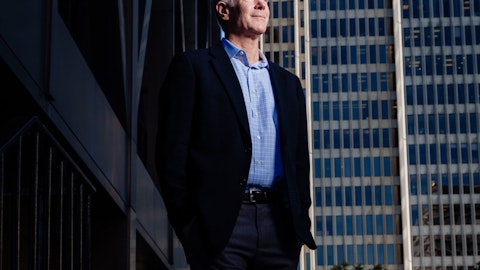Matt Pfau: Got it. That’s helpful. And then when we look at the number of net new customers or bookings coming from net new customers this quarter, it’s lower than that 35% in the pipeline this quarter. I think it was higher in the past several quarters before that. How do you sort of think about the ideal mix there where you’re bringing enough new customers on to have enough cross-sell opportunities down the road?
Eddie Capel: Yes. I think, look, clearly, it’s important to look at it at least annually, not as a quarterly number, if not even a longer duration. Our target is about a third. We feel like if we can get about a third of our new bookings from new logos, that will fuel the future cross-sell opportunity like crazy, frankly.
Dennis Story: Yes. And for the past 10-plus years, we’ve carried about a 30% to 35% new logo balance in our pipeline.
Matt Pfau: Great. Thanks guys. Appreciate it.
Eddie Capel: Our pleasure, Matt. Thank you.
Operator: Our next question is from Mark Schappel with Loop Capital Markets. Please proceed with your question.
Mark Schappel: Hi, thank you for taking my question and nice job on the quarter, exceptionally good job. Eddie, in an earlier question you noted that many of your new customers are coming from verticals outside of the core markets or the core verticals. I wonder if you could just go a little deeper into what verticals these customers are coming from? And also, how are — many of these new customers and new logos, how are they finding a way to Manhattan?
Eddie Capel: I think — well, first of all, industrial manufacturers, life sciences, high tech would be three that sort of jump out to me that are new or bigger verticals for us now than they were historically. And really, most of that work is driven by those companies doing something that’s more direct-to-consumer. It may not be direct-to-consumer in the purest sense of to the doorstep and so forth. But a lot of the life sciences and health care solutions companies, for example, are shipping smaller quantities, a very high value goods to individual pharmacies, doctors’ offices and so forth. So it looks just a lot more like retail. And that capability, as you know, requires a good deal of sophistication, a great deal of control and a great deal of precision. And so I think, look, we could talk a lot about this space. But those would be the highlights, I think.
Mark Schappel: Okay. Great. Thank you. And then one follow-up. On the marketing front, I mean, the company is very well known in the warehouse. It’s less known in, say, order management. I was wondering if you could just give us a little insight into what some of your marketing efforts are to drive awareness of your order management and point-of-sale solutions. I think you gave a little bit of that in your prepared remarks, you’re talking about some of the industry analysts, but I wonder if you could just expand on that?
Eddie Capel: Yes. Well, we feel pretty good about our position in the order management space. Now, Mark, to be perfectly honest with you, sort of the preeminent analyst in that space — analyst firm in that space tends to be Forrester. And for the last four to six years, they put us as the only leader — they have a Wave process versus a Quadrant, but we’re positioned as the only leader in that space. So we feel pretty good about our awareness there. Clearly, point-of-sale is where we’ve got to continue to cross the bridge and to bang the drum. We’re doing that. At every possible turn, we’re talking about the next generation of point-of-sale solution that we believe retailers need. And we’re not going to continue to stop banging that drum.
But there is that but of we’ve got to have a material number of live referenceable customers in that space to really get that flywheel going and be representative of what our solutions can do. And of course, the beauty of point-of-sale solutions is, you can test them as a consumer pretty quickly anytime you want. And so we feel good about getting the reach of our solutions out there. And the target has been to have, again, about a dozen referenceable customers for point-of-sale by the end of the year because it’s just my personal opinion, about that number starts to get sort of — to bring gravity and materiality to what we’re doing. We already operate from a store execution perspective. We’re a little — in a little over 20,000 stores today installed and live, not with point-of-sale, but with the execution system, buy online pick up in store, curbside pickup, store inventory management, ship from store, fulfill from store, all of those kinds of things live in over 20,000 stores.
And of course, our objective is to bring our point-of-sale solution to all of those stores and more as well and feel like we’re making pretty good progress.
Mark Schappel: Thanks. That was helpful. Thanks.
Eddie Capel: But let me just say, Mark, if you got any neighbors that are retailers, feel free to share the news, we will — we’d love everybody to be talking about it.
Mark Schappel: I’ll send them your way.
Eddie Capel: Thank you.
Dennis Story: Thanks.
Operator: Our final question is from Blair Abernethy with Rosenblatt Securities. Please proceed with your question.
Blair Abernethy: Thanks. Nice quarter guys. Just — Eddie, just following on your point-of-sale comments there. If you look 25 — customers, a total of 20,000 stores today, are you 10% penetrated that with POS or 5%? Is there some sense of how big that opportunity could be for Manhattan?
Eddie Capel: And the penetration, well, first of all, 20,000 as we’re proud of it is only scratching the surface and our penetration into that 20,000 is — don’t quote me, but somewhere in the 2% to 3% range. So that’s why we’re on one hand incredibly enthusiastic and excited about the space because we’re making good progress, it really isn’t impacting our financial results just yet, but of course, you can capture the vision forward in your mind forward and think about the potential positive impact that it can have on the future.
Blair Abernethy: Okay. Great. Thank you. And then just shifting over to the international business, both EMEA and APAC, growing at or above the company overall rate, which is encouraging. Can you just give us a little more color on what’s happening in EMEA and APAC for Manhattan? Is it — these net new customers, are they coming? Do you offer cloud in APAC? just kind of wondering what sort of — what’s the dynamic look like there from a new customer stand point?
Eddie Capel: Yes. Good question. So the answer is yes, we offer cloud across the globe, in fact, many of our customers are international and global organizations that are rolling out internationally, but so, yes is the answer to that question. In terms of both APAC and EMEA, the — if you look at the sub-regions or the countries inside of those theaters, some are more vibrant than others. Look, this is not the time to go down every single country and so forth, but if you go through Europe, you’d say, well, certainly, things in the UK are a little more suppressed than elsewhere. We used to have a not huge, but reasonably healthy business in Russia of course, which we’ve shut down, we can move to APAC and Australia is certainly quite vibrant, Southeast Asia is quite vibrant, China for a variety of reasons has been a bit slower, but look, that’s why we have an international business to help — supporting our customers where they need us to be, but also to smooth out some of those lumps here and there by specific region.
But at the end of the day, we’re managing through all that lumpiness region by region, I think, exceptionally well and that’s why you see the performance from the international markets.





